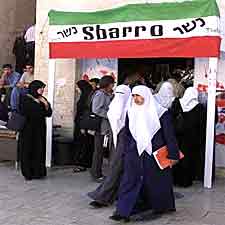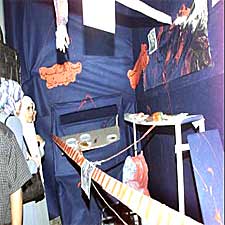In a lengthy, front-page New York Times feature about Palestinian youth (March 12, 2007), Steven Erlanger writes of the “lost generation of Palestine: its most radical, most accepting of violence and most despairing.” Quoting a dozen Palestinians, the article, entitled “Years of Strife and Lost Hope Scar Young Palestinian Lives,” tells a story of disillusioned youngsters “stymied” by “stateless[ness]”, an economy that is “shutting down,” “Israeli checkpoints, barriers and closures” and interaction with “armed” Israelis –“soldiers and settlers.” Erlanger also emphasizes the despair of parents who are dismayed by their children’s turn to violence. (Nothing is mentioned about the many parents who have been quoted boasting and taking pride in their children’s violent actions, what they call “martyrdom.”)
But by failing to discuss the critical factor turning the Palestinian youth to violence, namely, the state-sponsored anti-Israel indoctrination on PA-TV, radio, music videos, universities, and summer camps, Erlanger paints a deceptive portrait. (See “The Root of Palestinian Violence is Hate Education,” “Hate Indoctrination and Media Blindness,” “Ignoring Hamas Hate Indoctrination,” “The New York Times: Too Little, Too Late on Incitement,” “Save the Children,” “Teaching Hate Harms Children” and other CAMERA articles on Palestinian hate indoctrination.)
As the Times has done repeatedly in the past, the article glosses over the incitement that has produced a generation of militarized Palestinian youth. These youth are products of an upbringing that includes pervasive societal and media indoctrination of young children to become so-called “martyrs.” As children, they grew up with the Sesame Street-type children’s series, “The Children’s Club,” broadcast in the late 1990’s which featured Palestinian children singing in praise of martyrdom and jihad. They watched Palestinian television broadcasts urging children to drop their toys and pick up rocks to follow Palestinian shooting victim Muhammed al-Dura to the hereafter, which was portrayed as a green, sunlit meadow where young children play. They were spectators at public rallies and pageantry that featured Hamas members marching through the streets dressed as suicide bombers. They listened to religious sermons broadcast live on Palestinian TV on Fridays which often included calls to martyrdom.
Just last month, Hillary Clinton issued a press briefing in which she condemned the fact that Palestinian textbooks “don’t give Palestinian children an education, they give them an indoctrination.” Palestinian Media Watch concluded that the textbooks’ wholesale rejection of Israel can have only one consequence: “The well-meaning student is left with no logical justification or religious option to accept Israel as a neighbor or to seek coexistence.”
At the university level, the problem is also systemic. For example, as the Washington Times reported on March 5:
Al-Quds University last month held a weeklong celebration honoring Yahya Ayyash, the Hamas leader known as “the shahid [martyr] engineer.” He is credited with creating the first suicide belts in the mid-1990s and training the next generation of suicide bomb makers.
The opening event, as reported by a Palestinian newspaper and found in the PMW report, included a speech by university administrator Yusuf Dhiyab, “who discussed shahids and the mark that the shahids left on the history of the Palestinian nation and how they succeeded in uniting the nation.”
And who can forget the infamous exhibit at An-Najah University in 2001—the very same university which produced several students whom Erlanger interviewed for the article—celebrating violence against Israelis with a re-enactment of a suicide bombing in a pizzeria that killed 15 Israeli civilians (mostly women and children)?
|
|
| |
| Palestinian students visit a re-enactment of the Sbarro pizza restaurant suicide bombing at An-Najah University | Re-enactment of Sbarro bombing at An-Najah University included replicas of body parts and pizza slices strewn across the room |
Erlanger, however, provides just one sentence in the almost 3400 word article about indoctrination of Palestinians, presenting it as an Israeli claim:
Many Israelis agree that the current generation of young Palestinians has been thoroughly radicalized, but say that it is the product of Palestinian political and religious leaders who have sanctioned and promoted violence and terrorism against Israel.
He also includes an occasional oblique allusion. For instance, he writes:
“Israel should leave this land,” [16-year-old Ayman] said angrily, then repeats what he has been taught, that all of historic Palestine belongs to Muslims.
There is nothing in the article, however, to indicate that the “territory riven by infighting, seared by violence, occupied by Israel, largely cut off from the world and segmented by barriers and checkpoints,” is also filled with government-sanctioned hate indoctrination via the television, nursery schools and universities, religious institutions, summer camps, and sporting events.
The Hothouses of Gaza
The article contains a section entitled “The Hothouse of Gaza” in which the strip is described as
a poor, chaotic place of 1.5 million people, 70 percent of them refugees and their descendants . . . [whose] people are even more constrained by Israeli and Egyptian security restrictions on their travel [compared to their West Bank brethren]. There are few jobs than in in the West Bank, and even more weapons.
With the economy of Gaza shutting down, much of the work available for young people is either in the swollen and disorganized security forces or in the armed militias or gangs . . .
But the coupling of “hothouse” along with “Gaza” brings to mind another sort of “hothouse” — the agricultural hothouses left behind by Israel when Israel fully withdrew its settlements and its military from the Gaza Strip well within the lifetime of this generation of lost Gazan youth — less than two years ago. But Erlanger doesn’t even mention the historic and first wholesale uprooting of Jewish communities in land that Palestinians claim as their own. Presumably, the complete, unilateral relinquishing of land to Palestinians does not fit into his narrative of a “destroyed generation” whose members “never see anything good in [their] lives”?
Israel’s withdrawal from Gaza would certainly have been an interesting factor to consider in light of the radicalization of the Gaza youth. For instance, did the disengagement have a moderating or radicalizing effect on the young population? In the wake of the withdrawal, why weren’t agricultural jobs made available in the vacated, intact hothouses? Given the potential opportunities, why did the young continue to turn to the terror groups?
Violence Romanticized


